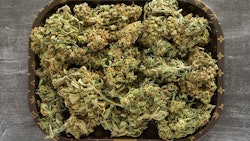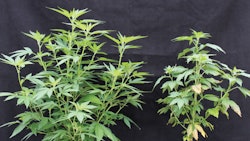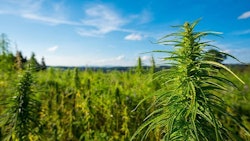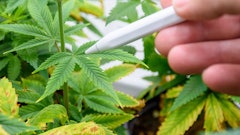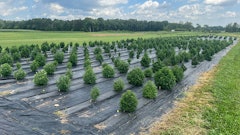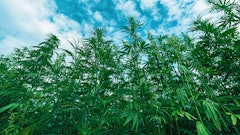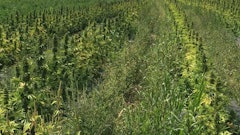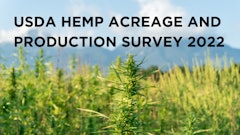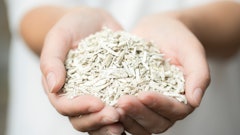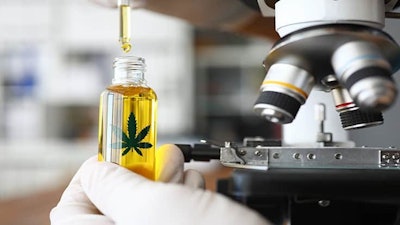
A study from Oregon State University (OSU) made waves this month when it demonstrated three cannabis-derived compounds–cannabigerolic acid (CBGA), cannabidiolic acid (CBDA), and tetrahydrocannabinolic acid (THCA)–have the potential to prevent the coronavirus from entering human cells.
Other recent research has shown promise for cannabinoids’ potential in fighting off infection, including research from Canadian-based Waterloo University and Michigan State University, the latter in collaboration with GB Sciences.
The recent attention regarding cannabinoids’ medicinal potential has incited excitement among the hemp and cannabis industries and even caught fire in the mainstream.
But some researchers are urging the public to take caution amid these findings–the research still has a long way to go to prove what, if any, effects can play out in humans. “You go into these things hopeful that they’re going to pan out to match the hype,” says Dr. Ethan Russo, M.D., a board-certified neurologist and founder of CReDO Science, “a biopharma holding company that exists to solve problems of the human/animal [endocannabinoid systems] including developing optimized formulations from the cannabis plant for better living,” according to the company’s website. “But something everyone has to realize straight out of the shoot is there’s this tremendous gulf between lab results and what may be achieved clinically.”
The Oregon Research
The OSU study has shown exciting preliminary results for Richard van Breemen, a researcher with Oregon State’s Global Hemp Innovation Center, College of Pharmacy, and Linus Pauling Institute.
“This could be a once-in-a-lifetime event,” he says.
Van Breemen led the OSU study, which was published in the peer-reviewed Journal of Natural Products.
“It was a two-step process we used: Initial discovery with analytical chemistry, and then a functional cell-based test that showed activity,” van Breemen says.
During the initial discovery phase, van Breemen and his team studied a range of botanical products’ effects against a spike protein found in SARS-CoV-2 (the virus responsible for COVID-19). Full-spectrum hemp oil and more refined hemp oil products were part of that lineup, van Breemen says.
Using a mass spectrometry-based screening technique invented in van Breemen’s laboratory, the researchers found CBDA, CBGA, and THCA all bound to the SARS-CoV-2 spike protein, “blocking a critical step in the process the virus uses to infect people,” according to an OSU press release.
The researchers then tested an equal amount of each cannabinoid found in the hemp oils on the virus. Notably, van Breemen says, CBD and CBG did not bind to the spike protein like their acidic forms did.
From there, the researchers moved to the functional phase in collaboration with other researchers from Oregon Health & Science University, testing CBGA, CBDA, and THCA on the live virus using human cells. “The functional tests showed the compounds had antiviral activity,” van Breemen says.
Importantly, the researchers found “there are at least two different places on the spike protein of the virus to which these compounds bind,” he says, meaning that while one of the compounds could be effective against shortening or even completely blocking infection, combining the compounds could prove to be even more effective.
The OSU team plans to continue looking into the potential of combination therapy. They’re also working to set up clinical trials to test their findings on human subjects. Once the study is set up, van Breemen anticipates results could come “before the year is over.”
"Something everyone has to realize straight out of the shoot is there’s this tremendous gulf between lab results and what may be achieved clinically.” - Dr. Ethan Russo, M.D., founder, CReDO Science
It’s unknown whether any current products on the market contain enough CBDA, CBGA, or THCA to yield potential benefits, van Breemen says. But ultimately, he envisions these results could be replicated in an oral dietary supplement that is used in combination with vaccines.
“Based on what’s in the literature, we predict these concentrations are achievable therapeutically,” van Breemen says.
Industry Reactions
Russo, however, questions whether the concentration needed for these compounds to be effective in humans, as cited in van Breemen’s research, is realistic. A concentration of any compound beyond 10 micromolars is “hard to achieve in a living organism,” Russo says, and OSU cites even higher concentrations needed for the CBDA, CBGA, and THCA to be effective against the virus.
“I really heartily disagaee that these are achievable concentrations by oral administration, which is likely the only reasonable way to do it. … I don’t believe you could systemically administer these agents and get the kind of concentrations that would be necessary,” Russo says.
“It’s really unfortunate because CBGA and CBDA are things you could make a lot of growing in the field,” Russo adds. “But it doesn’t matter how much you can make if you can’t get enough of it into the body in a reasonable way.”
Even if the concentrations are achievable, Russo still urges caution about the results. Clinical trials often yield different results than those demonstrated in a lab. And acidic versions of cannabinoids are notoriously unstable. When exposed to heat or light, they tend to break down into their “respective neutral cannabinoids,” Russo says, which the OSU study found to be ineffective in this instance–for example, CBGA would convert into CBG, and so on. (This is why smoking cannabis would not produce the effects shown in the studies; heat applied to THCA converts it to the psychoactive cannabinoid THC.)
Cannabis scientist and educator Dr. Greg Gerdeman, Ph.D., president and CEO of NASHCX (Nashville Commodities Exchange), sees the research in a different light.
“I think it’s compelling,” Gerdeman says of the research, adding that he’s eager to see industry lobbyists push for more research regarding cannabinoids and SARS-CoV-2. “Let’s make it more solid by putting an absolute research priority on this. I think it’s very high-quality modeling work.”
Russo agrees that the research is needed and “could be the basis for something,” especially if the compounds are proven to work together as a combination therapy.
“It’s the type of research we do want to see,” he says. “I just think it’s been oversold.”
Other Research
Despite the skepticism, more preliminary research is emerging that shows complementary effects of cannabinoids against COVID-19.
Researchers from Michigan State University have been working with a team at GB Sciences, a plant-based research and biopharmaceutical drug development company, to develop cannabinoid formulations that can reduce dangerously high cytokine levels sometimes triggered by SARS-CoV-2. In December, the research team announced that a third of their proposed cannabinoid-containing formulations seemed to be effective, and they are currently awaiting publication of their research paper on the subject.
At Waterloo University, researchers recently found synthetic CBD could effectively prime human cells to ward off initial waves of SARS-CoV-2 infection. Their study is currently under peer review by the journal Life Sciences.
“I would emphasize that people should not just go out and try to do this and replace everything that is known to work with something that is clearly experimental at this point in time.” - Robin Duncan, lead investigator and professor, University of Waterloo
Their research was twofold: They wanted to learn how certain SARS-CoV-2 genes interact with the body, and they wanted to see whether CBD could help with the effects. The researchers studied synthetic CBD because Canada doesn’t currently have pharmaceutical-grade CBD available, says Robin Duncan, lead investigator and a professor in the University of Waterloo's Department of Kinesiology and Health Sciences.
Duncan explains that typically, once viruses enter human cells, they want to turn the cells into “a little factory” to make more of the virus. However, human cells have a system to recognize the virus and fight it off before the infection begins to spread to the rest of the body.
Cells detect the virus by chopping up the genes and analyzing the data. If they uncover that the virus has invaded, the infected human cells die–which is all evidence of a healthy system at work and prevents the infection from spreading to other cells.
However, the researchers were finding that when they inserted proteins from SARS-CoV-2 into human kidney cells, the cells were not triggering this reaction that typically fights off infection.
“Nothing seemed to happen, and that’s bad news. You want your cell to respond to them,” Duncan says. “That’s the problem with this virus: There’s a very poor response, so it spreads very easily.”
But something unexpected happened when the researchers inserted CBD into healthy kidney cells. “The [defense] system went through the roof, but the cells didn’t die,” Duncan says. “It was like they were prepared for invasion, but no harm came from it.”
Duncan says the CBD triggered a defensive response in the cells, seeming to prime them for future infection.
Once researchers added the SARS-CoV-2 protein to cells that had been primed with CBD, they demonstrated the full, healthy defense response that human cells typically show against other viruses. The researchers saw these effects on the COVID-19 virus 14 hours after giving the cells a dose of CBD.
Duncan says the researchers used a dose of CBD that would be more akin to the concentration found in Epidiolex, the only FDA-approved CBD medication in the U.S. Epidiolex contains higher concentrations of CBD than those found in hemp-based products currently on the market. “Even extracts I’ve seen with the highest CBD wouldn’t be enough without getting a high amount of THC, and we don’t know how they interact,” Duncan says.
RELATED: Global Companies Expand Work on Cannabis-Based Epilepsy Treatments
Still, the results show promise against SARS-CoV-2–and potentially against other viruses as well, Duncan says. What’s more, the results found by Waterloo’s researchers demonstrate a separate, complementary effect to what the OSU researchers found.
The Waterloo researchers also hope to set up clinical trials to test their findings in human subjects, but Duncan is encouraged by recent research she’s seen. A University of Chicago study conducted in 2021–which was published in the peer-reviewed journal Science Advances Jan. 20 of this year–found that patients taking Epidiolex had significantly fewer cases of COVID-19 than the general population. The results show that CBD “can block SARS-CoV-2 infection at early and even later stages of infection,” the study reads.
“In matched groups of human patients from the National COVID Cohort Collaborative, CBD (100 mg/ml oral solution per medical records) had a significant negative association with positive SARS-CoV-2 tests,” the study continues. “This study highlights CBD as a potential preventative agent for early-stage SARS-CoV-2 infection and merits future clinical trials.”
Still, even Duncan cautions that cannabinoids are not a replacement for medications that have been proven to work.
“It's not a replacement for masks and vaccines. Really, ideally, I would see it used as a support for those things–something that could help lower the risk along with them,” Duncan says. “I would emphasize that people should not just go out and try to do this and replace everything that is known to work with something that is clearly experimental at this point in time.”
Editor's note: Associate Editor Andriana Ruscitto contributed to this story.









